Scouting in New Jersey has a long history, from the 1910s to the present day, serving thousands of youth in programs that suit the environment in which they live. The second Boy Scouts of America National Headquarters was in North Brunswick, although it was referred to in BSA publications as being in neighboring New Brunswick.
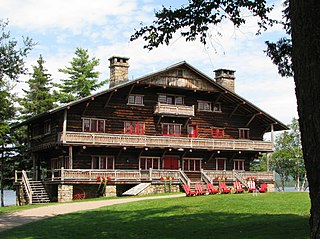
Great Camp Sagamore is one of several historic Great Camps located in the Adirondack Mountains of northern New York State.

Treasure Island is a former Boy Scout property located between Point Pleasant, Pennsylvania and Frenchtown, New Jersey, United States. The property is situated on two islands in the middle of the Delaware River and was owned by the Cradle of Liberty Council. Treasure Island was the second oldest continually operated Boy Scout Camp, behind Owasippe Scout Reservation in Michigan, in the country and had been continuously associated with Scouting since 1913.

List of the National Register of Historic Places listings in Franklin County, New York

Eagle Island is an island in Maine's Casco Bay and the site of the summer home of the polar explorer Admiral Robert Peary (1856-1920). The island and home are preserved as the Eagle Island State Historic Site

The Santanoni Preserve was once a private estate of approximately 13,000 acres (53 km²) in the Adirondack Mountains, and now is the property of the State of New York, at Newcomb, New York.
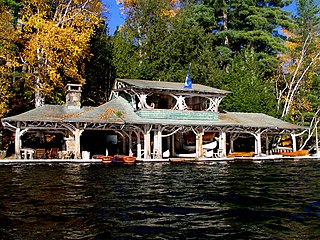
The Great Camps of the Adirondack Mountains refers to the grandiose family compounds of cabins that were built in the latter half of the nineteenth century on lakes in the Adirondacks such as Spitfire Lake and Rainbow Lake. The camps were summer homes for the wealthy, where they could relax, host or attend parties, and enjoy the wilderness. In time, however, this was accomplished without leaving the comforts of civilization behind; some great camps even contained a bowling alley or movie theatre.
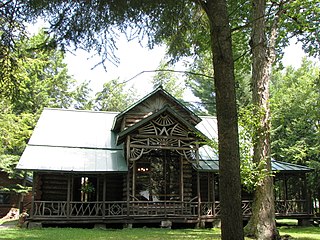
Camp Pine Knot, also known as Huntington Memorial Camp, on Raquette Lake in the Adirondack Mountains of New York State, was built by William West Durant. Begun in 1877, it was the first of the "Adirondack Great Camps" and epitomizes the "Great Camp" architectural style. Elements of that style include log and native stonework construction, decorative rustic items of branches and twigs, and layout as a compound of separated structures. It is located on the southwest tip of Long Point, a two-mile long point extending into Raquette Lake, in the Town of Long Lake in Hamilton County, New York.

Camp Uncas is an Adirondack Great Camp, the second built by William West Durant for his own use. It lies on the shore of 110-acre (45 ha) Lake Mohegan, near Great Camp Sagamore, and was completed in two years.

Upper Saranac Lake is one of three connected lakes, part of the Saranac River, in the towns of Santa Clara and Harrietstown, near the village of Saranac Lake in the Adirondacks in northern New York. Upper Saranac Lake is the sixth largest lake in the Adirondacks. With Middle Saranac Lake and Lower Saranac Lake, a 17-mile (27 km) paddle with only one carry is possible. There are 20 primitive campsites accessible by boat available on a first-come basis. Upper Saranac Lake is also known as Sin-ha-lo-nen-ne-pus.
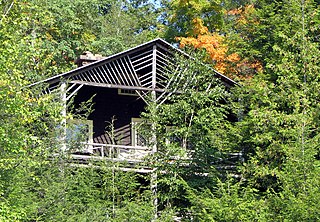
Moss Ledge is an Adirondack Great Camp designed by William L. Coulter in 1898 for Isabel Ballantine of New York City. Ballantine was the granddaughter of Newark beer baron, John Holmes Ballantine.

Prospect Point Camp is an Adirondack Great Camp notable for its unusual chalets inspired by hunting lodges. William L. Coulter's design is a significant example of the Adirondack Rustic style. It is located on a bluff overlooking the northern reaches of Upper Saranac Lake, near Eagle Island Camp and Moss Ledge, two other Coulter designs. Its grand scale is typical of the opulent camps of the area in the great camp era. The camp was built for New York copper magnate and financier Adolph Lewisohn.

The Northern New Jersey Council was formed in January 1999 and serves Bergen, Essex, Hudson and Passaic counties as an effort to better serve the Scouting communities encompassed in these areas.
Camp Paxson Boy Scout Camp, located on the western shore of Seeley Lake, Lolo National Forest, Montana, is on the National Register of Historic Places. It started out as a summer camp for the Boy Scouts of America (BSA), and is named in honor of Montana western painter Edgar Samuel Paxson. The United States Forest Service granted the Western Montana Council of the BSA permission to build a summer camp, originally with six small 12x24' clapboard structures and tents on just 4 acres (1.6 ha), in 1924. The camp was expanded beginning in October 1939, with more facilities constructed by the Works Progress Administration and Civilian Conservation Corps (CCC). The camp was completed in 1940 on 6.7 acres (2.7 ha) under the supervision of Forest Service engineer Clyde Fickes.

Lacawac is an historic, American estate that is located in Paupack Township and Salem Township, Wayne County, Pennsylvania.
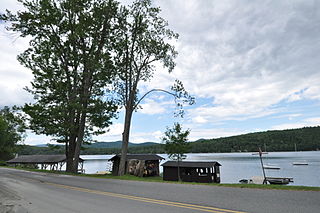
Aloha Camp is a summer camp for girls on Lake Morey in Fairlee, Vermont. Founded in 1905, it is the oldest girls' camp in the state. Open to children aged 12 to 17, it offers outdoor activities, arts and nature programs, and wilderness camping opportunities. The camp season is divided into two sessions of 3-1/2 weeks, running from late June to mid-August. The camp property is listed on the National Register of Historic Places.

Aloha Hive Camp is a summer camp for girls on Lake Fairlee in West Fairlee, Vermont. Founded in 1915 as an expansion of Aloha Camp, it is open to girls aged 7 to 12, with two sessions between mid-June and late August. The camp operates on more than 400 acres (160 ha), offering a variety of outdoor activities as well as a rich arts and crafts program. The camp facilities were listed on the National Register of Historic Places in 2003.
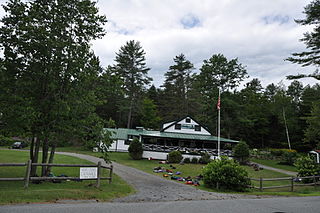
Aloha Horizons Camp is a summer camp for boys and girls on Lake Fairlee in West Fairlee, Vermont. Opened in 1921 as Camp Wyoda, its property was acquired by the Aloha Foundation in 1997, and is now operated by that organization as a day camp for local children and vacationers staying in the area. Camp is divided into three two-week sessions; activities include water sports, land sports, and arts and crafts. The camp property, organized around a former farmstead, was listed on the National Register of Historic Places in 2003 for its well-kept collection of surviving early camp architecture.

Lanakila Camp is a private summer camp for boys on Lake Morey in Fairlee, Vermont. Founded in 1922 on the grounds of a 19th-century farm property, it is one of the state's older organized camps, with a significant number of period buildings in the Adirondack rustic style. The camp offers an array of outdoor activities, including water and field sports and hiking, and indoor arts and crafts programs, all generally infused with an educational purpose. It has a full 7 and a half week session, as well as two three-week sessions, typically running from late June to mid-August. During the off-season, its facilities are used as the Hulbert Outdoor Center, an educational center for adults, children, school groups and special events. The camp property was listed on the National Register of Historic Places in 2003.
Camp Marbury was a summer camp for girls on Lake Champlain in Ferrisburgh, Vermont. Founded in 1921, the family-run camp operated until 1942, when it closed due to logistical difficulties associated with World War II. The camp property is listed on the National Register of Historic Places.


















